The Academy of the New Church
1876-1926
Environment—Frances Margarita Buell
Social Life in the Academy Schools—F. M. Buell and K. R. Alden
Athletics
Scholarships—Charles Emil Doering
Environment and Equipment top
Fifty years ago the equipment of the Academy was in the form, it may be said of one five hundred dollar check signed by John Pitcairn. The name Bryn Athyn was unknown, and the land now included in the borough was then a countryside of farms and orchards. Among the farms were the "Lesher Farm," in the place of the present Inn Annex; "Knight's Hill," which later became the Cairnwood estate, the "Opdyke Farm," now the campus; the "Marsh Farm," now the home of Mr. Edward C. Bostock. The railroad station name was "Alnwick Grove," and there was a picnic pavilion near it overlooking the Pennypack Creek.
The neighborhood is full of stories of colonial and revolutionary days, such stories as Penn's purchase of the land lying between the Schuylkill and the Pennypack, and a further purchase of land "on both sides of the Pennypack and extending in a northwest direction two full days' journey"; also such stories as the revolutionary skirmish at Hatboro; the soldiers' march below Huntingdon Valley; stories of the Lady Washington Inn, Paper Mills, Langstreth, the old Second Street Turnpike, and Graeme Park. The Delaware is only seven miles away; and Philadelphia only fifteen.
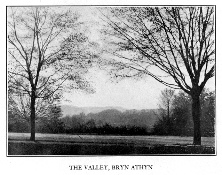
The Valley.
Click on image for a larger version.
With the passing of fifty years have come remarkable changes. John Pitcairn augmented his first five hundred dollar check many times. In 1893, after much deliberation, the beautiful Alnwick Grove tract of land was decided on; later the avenues of trees were planted, a few houses were built, hedges bordered the roads, a frame addition was built on the west end of the old Lesher house and used for many purposes; a frame school building was built later and used for many other purposes. The name "Bryn Athyn" was chosen, groups of stone buildings were built and equipped for growing Academy uses. More people came to live in Bryn Athyn, and more students came to the schools.
The Academy plant includes at present Benade Hall, used for the administration offices, the Book Room, the Girls' Seminary, the Boys' Academy, the chapel services, the science and physical education department; the Library with the Theological School, and also the Museum above the reading room floor, and the College recitation rooms below; De Charms Hall, including the Elementary School and an auditorium with a stage; Stuart Hall, a boys' dormitory; Glenn Hall, a girls' dormitory; a dining hall; a power house; a farm; an inn, and several residences. The campus is about eighteen acres in extent and includes an unusually good football field and six tennis courts.
With the growth of the Academy there has been a parallel growth of Bryn Athyn. Land has been added to the original tract, and new roads and houses are continually being built. Bryn Athyn was incorporated as a borough in 1916, when the Rev. C. E. Doering was elected first burgess. The Bryn Athyn Cathedral was dedicated in 1919, and became at once a center of the worship and ritual of the General Church. Its beauty attracts thousands of visitors, and the fine architectural development of the successive parts of the structure has commanded the attention of architects and artists.
FRANCES MARGARITA BUELL.
Social Life top
From the very beginning a happy social life has characterized the Academy. How much the spirit of good will, ultimated in social functions, has meant may be seen by thinking for a few moments of the Academy movement divorced from this element of its life. The founders of the Academy were serious, courageous and farsighted in theological affairs, but they were also fortunate in establishing social customs which inspired happiness and order, and made a basis for charitable good fellowship.
In the school announcement for 1879 the statement was made: "Our students in their social life in the city are surrounded as far as may be with the sphere of the New Church." When the New Church Life was begun in 1881, the first sentence of the first page of the first number of the first volume again shows us that social life has far-reaching consequences. To quote: "A few years ago, about thirty of the young people connected with the New Church in Philadelphia, formed a club for intellectual and social culture." From this club developed the New Church Life, and to this club is due much of the stability of the Academy work.
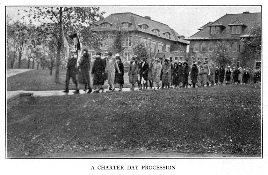
Charter Day.
Click on image for a larger version.
Social life in the Academy schools at the present time is more complete and sustained than students usually can find elsewhere. The biggest event in the year is the Charter Day celebration, which includes a Cathedral service, preceded by an academic procession of the faculties and students, with academic insignia and all the class and school banners. It usually includes speeches on the campus, a football game, a dance for all students and ex-students, and a supper for the ex-students and the faculties. Many ex-students come back to Bryn Athyn at this time.
Other social events are the President's receptions in September and June, attended by the faculties, the board of directors, ex-teachers and guests of the Academy, together with the entire student body, and all of the parents who are able to be present. There are also school dances during the year, on an average of one a month. Groups of students act as committees representing the College, the fourth and third year classes of the secondary schools, the Deka, the Alpha Kappa Mu, and the Academy Athletic Association. They arrange the program, take charge of expenditures and decorations, and receive with the faculty committee. The dances end at eleven o'clock, usually with the singing of the school song.
In addition to the dances there are also plays, pageants, operettas, cantatas usually one such event emphasized each year. There is also campus social life picnics, suppers, games and song rallies. The various clubs entertain each other yearly.
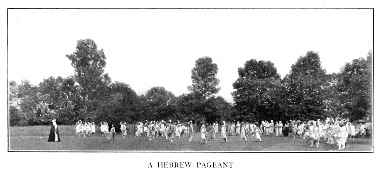
A Hebrew Pageant.
Click on image for a larger version.
The first student organization of any kind was the "Academy Athletic Association," which organized first for the purpose of providing athletic recreation. The athletic club has had a long and varied career. About 1908 the "Topic Club" combined with it, and for more than a year literary subjects were introduced into its meetings. This gradually died out, and the meetings were held purely for the purpose of promoting athletics. In 1921 it discontinued its meetings, and was not revived again until the fall of 1925, when it was recalled to life to take charge of the weekly "Forum" of the Boys' Academy.
The "Forum" is a parliamentary body run by the students of the entire Boys' Academy, and supervised by the faculty. It meets weekly, the last hour on Friday, and affords an opportunity for all the boys to work together for a common end. It handles the business of the Athletic Association, and the officers of the two -bodies coincide. The president presides over all meetings, and the secretary records the minutes, while the treasurer keeps account of the funds, which are banked with the treasurer of the Academy. The president is ex-officio the chairman of the Student Committee, and a member of the School Committee on Athletics.
Since 1907 other student clubs have been formed, each under the guidance of a faculty supervisor. The oldest of these clubs is the "Deka." The "Deka" is a club of Glenn Hall girls, under the supervision of the housemother of Glenn Hall, the girls' dormitory. It was founded in 1907 by all the students living in the dormitory that year. Its purpose was to bring the girls together to maintain a standard of honor, a happy Glenn Hall life, and a spirit of sisterhood with the Bryn Athyn girls. The club colors are brown and white. They have a book of "Deka" songs which has been enlarged from time to time. They carry out the traditional annual customs of Glenn Hall social life, take care of things of general use in the building, conduct club meetings, suppers, entertainments, teas and picnics. They also act as a committee for one of the school dances each year, and hold a weekly dancing class for the new pupils.
The first boys' fraternity was organized in the spring of 1909. It was called the "Phi Alpha," and it was designed to fulfill a long-felt need for some form of self-government, and some tie that would unite the dormitory boys more closely together. Membership in it was limited exclusively to boys who were living in Stuart Hall. It had for its general ends the promotion of love toward the Alma Mater, and the promotion of good fellowship among its members. The fraternity now lacks only three years of its twentieth anniversary, and during this time it has performed many important uses. In the first place it has the means and the traditions for welcoming and absorbing into student life the new boys that come to our institution. It also has the means for instilling a high code of morals and honor, and it forms a useful contact with the older boys who have gone through the schools.
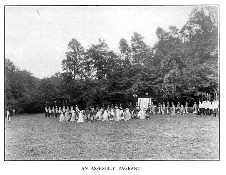
An Assembly Pageant.
Click on image for a larger version.
Its activities are mainly social, and include each year a series of banquets at which the active members, and the graduated members, get together and discuss the ideals and aims of the fraternity. There is usually an entertainment given to the "Deka," and always a dance. Sometimes a theatrical event is given, and on two occasions it has published a year book of its activities. The president of the fraternity governs the body, assisted by a secretary, treasurer and other minor officers. In the performance of all these uses the boys have actual experience of a valuable nature in the handling of affairs.
The "Sigma Delta Pi" is a fraternity composed of the boys who live in Bryn Athyn. It is two years younger than the Phi Alpha, its birthday being in the spring of 1911. The Academy has furnished it with a room of its own on the first floor of Benade Hall. Its main uses are essentially the same as the Phi Alpha, that is, the promotion of love toward the Alma Mater, and good fellowship among its members. The chief difference between the two fraternities arises from the fact of their different constituents. One fraternity has for its chief aim the harmonizing of boys' lives who never have known each other before, while the other strives to bring into order and harmony, and the desire to strive for a common good, boys who have known each other all their lives, and who may have misunderstandings that date back to childhood. Both uses are essential to the well-being of the school and for many years now they have been carried on with success. In the springtime, picnics and camping parties become prominent in the life of both of the fraternities.
The "College Club" was organized in the school year 1915-1916. It included in its membership the theological students and the young men and young women of the College department. Its first aims were intellectual and artistic, and its secondary aims were those of social life. During its first five years of existence many noteworthy essays were presented for discussion, plays were given, and musical entertainments and lectures on art espoused. Prior to the present year it fell into a period of inactivity, but it has now been revived by the College women.
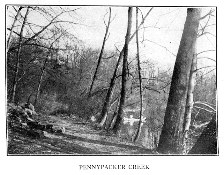
Pennypacker Creek.
Click on image for a larger version.
Youngest of all the clubs is the "Alpha Kappa Mu," which is composed of the Bryn Athyn girls who are day pupils in the Seminary. It was founded in 1918. Its purpose is "to insure affection and friendship among its members, that they may serve their Alma Mater and create good fellowship between Deka and Alpha Kappa Mu." They are under the guidance of one of the Seminary teachers, and have a club room in the school building. They have painted the furniture and decorated the room in orange and blue, their colors. Their banner is blue velvet with a motto in gold: "Mia pasi pasai mie." Business and social meetings are held Tuesday afternoons. The club often assists in school activities and acts each year as a committee for one of the school dances.
Alpha Kappa Mu forms a strong tie between the Bryn Athyn school girls, and brings them into close contact, so that they may share their advantages.
KARL RICHARDSON ALDEN. FRANCES MARGARITA BUELL.
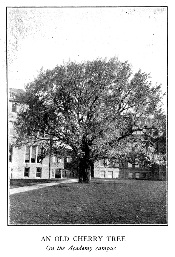
An Old Cherry Tree.
Click on image for a larger version.
Athletics top
The physical education program now in practice at the Academy of the New Church is flexible enough to meet the needs of the groups attending in any particular year. In general it includes graded gymnastics and games for both boys and girls, and interscholastic competition in football, baseball and tennis for the boys. During the second semester of this year the work of the department was extended to cover the elementary school. Next year supervised physical training will form part of the curriculum of all grades.
It is in the field of sports that the work of the department is best known. Our football teams play a six to eight game schedule with the high and preparatory schools of Philadelphia and vicinity. Considering the size of the student body our teams are usually quite successful. Tennis has been carried as a spring sport for two years. Twelve match schedules are arranged in this sport and the Academy teams have shown exceptional skill. Bryn Athyn baseball has not been a success considered from the number of games won in the past. It does fill a need in the school life of the boy by providing for the exercise of that loyalty to the teams which is not supplied by tennis.
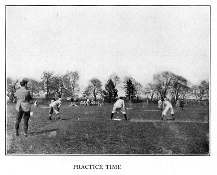
Practice time.
Click on image for a larger version.
There is no interscholastic competitions arranged for the girls. Color competitions have been successfully tried as well as informal group games of a competitive character.
Our excellent athletic field, though not large enough for a track, affords ample space for football, baseball and group games-four tennis courts, two for boys and two for girls, provide for this sport.
The mid-term work consists of two periods per week in the gymnasium for each student. The aim in these classes is to correct faulty posture and to secure adequate motor control. Games supplement the gymnasium lessons.
Every student must undergo an examination given by the school physician, at the beginning of the school year. A report of the condition of each pupil is filed with the directors and a summary mailed to the parents or guardians. Upon recommendation of the examining physician students are excused from participation in the physical educational program or their activities are limited to certain types of exercises.
FREDERICK ADAM FINKELDEY
Scholarships top
From the beginning of its existence the Academy, recognizing the value of a New Church education for building up the Church among its members, has made every effort to make it possible that education should be within the reach of all. This at first took the form of giving financial aid to theological students. Later, tuition scholarships were given to others.
In 1902, the Academy appealed to the General Church for funds in support of a larger number of scholarships, as well as to secure general interest in education. Theta Alpha then took up the use of supporting honor pupils in the Girls' Seminary. Some years later, the Sons of the Academy relieved their Alma Mater of making the annual appeal for funds; and they have since supported every boy or girl recommended by the Academy. Various bequests also have been left to the Academy for scholarships; so that now the desire that existed from the beginning is made possible, namely, that every worthy New Church boy and girl may receive a New Church education.
These scholarships or stipends are of various types and kinds.
In certain cases stipends, consisting of board and tuition, are granted to approved students in the college and theological school, to enable them to pursue professional courses, either in preparation for teaching, or for the ministry of the New Church.
Scholarships are offered to both secondary pupils and college students. They are of three kinds: (1) Those that provide for part tuition only; (2) Those that provide for board only, $320; (3) Working scholarships. In the case of working scholarships part of the tuition is remitted by the Academy . Part of the expense of board is paid either by the parent, or by some scholarship fund, or by both. The remainder is earned by the student by working five hundred hours during the year for the Academy. The student must pay fifty dollars in cash on account of board and tuition.
Scholarship aid will be considered forfeited, if the conduct of a scholarship student is not satisfactory, and his scholastic standing not above an average of seventy-five.
These scholarships offered by the Academy are available as a result of the activities of the following contributing bodies:
1. THE ACADEMY OF THE NEW CHURCH, as Trustee of the following funds:
-
(a) The Vera Pitcairn Scholarship Memorial Fund.
(b) The Fred Synnestvedt Scholarship Memorial Fund.
(c) The Roy Wells Scholarship Memorial Fund.
(d) The Charles Francis Browne Scholarship Memorial Fund.
2. THETA ALPHA: This association, consisting of former students of the Girls' Seminary, and of former women students of the College, has been primarily interested in contributing scholarships to honor students of the Girls' Seminary.
3. THE SONS OF THE ACADEMY, an organization of men who are ex-students of the Academy schools (or members of the General Church interested in the uses of education as developed by the schools of the Academy of the New Church) has since 1908, been authorized to collect general funds for Academy scholarships, and has for a number of years undertaken to arouse interest in the support of scholarships throughout the General Church of the New Jerusalem.
CHARLES EMIL DOERING,
Dean of Faculties.